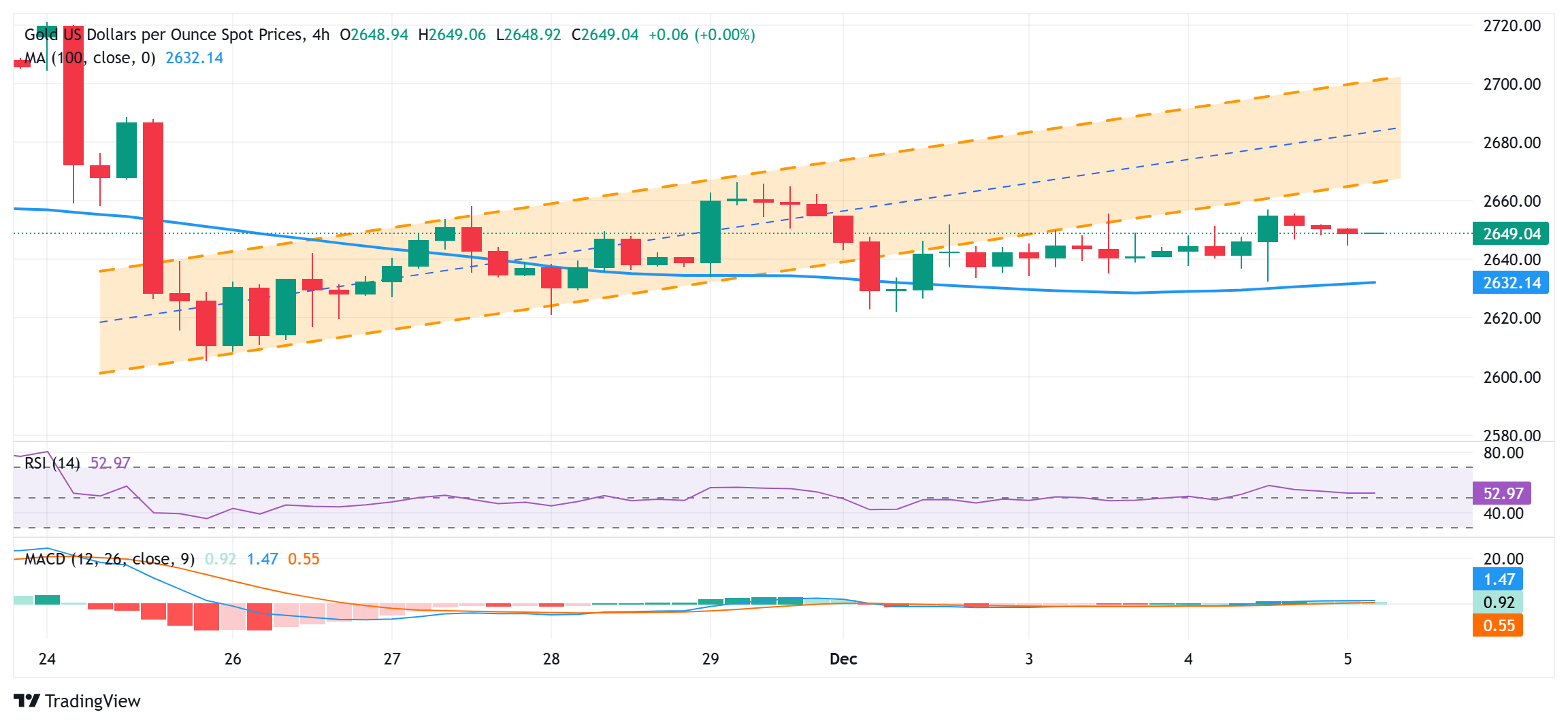- The price of gold is attracting some sellers amid a modest rally in US bond yields.
- Geopolitical risks and trade war fears could help limit losses for XAU/USD.
- USD bulls stay on the sidelines ahead of Friday’s key US NFP report.
The price of gold (XAU/USD) declines during the Asian session on Thursday, although it remains confined to a familiar range maintained for the last week or so amid mixed fundamental signals. Hardline statements from FOMC members overnight, including Federal Reserve (Fed) Chair Jerome Powell, reaffirmed expectations that the US central bank will take a cautious stance on rate cuts . This helps US Treasury yields rebound slightly from their lowest closing levels in more than a month and turns out to be a key factor undermining the underperforming yellow metal.
Apart from this, the prevailing risk environment puts some downward pressure on the safe haven gold price. That said, lingering geopolitical tensions stemming from the worsening conflict between Russia and Ukraine and concerns over US President-elect Donald Trump’s tariff plans could act as a tailwind for the XAU/USD. Additionally, the lack of any significant buying of United States Dollars (USD) should help limit losses for the commodity. Traders could also choose to wait for the release of the US Nonfarm Payrolls (NFP) report on Friday before taking directional positions.
Gold Price Lacks Firm Near-Term Direction as Traders Await More Signs on Fed Rate Cut Path
- The Federal Reserve’s Beige Book on Wednesday showed that U.S. economic activity expanded slightly in most regions since early October, with inflation rising at a modest pace and businesses expressing optimism about the future.
- St. Louis Fed President Alberto Musalem said it might be appropriate to pause interest rate cuts as soon as the December meeting, as the risks of reducing borrowing costs too quickly are greater than the risks. of making too little flexible.
- Fed Chair Jerome Powell acknowledged that the US economy is in very good shape and is definitely stronger than expected and that the central bank may take a slightly more cautious approach in lowering interest rates. towards a neutral level.
- Separately, San Francisco Fed President Mary Daly said there is no sense of urgency to lower interest rates and that much work remains to be done to meet the 2% inflation target and lasting economic growth. .
- Additionally, speculation that US President-elect Donald Trump’s policies will revive inflation suggests the Fed could stop cutting rates or possibly raise them again, triggering a modest rally in bond yields. Americans.
- The 10-year US government bond yield rebounds after recording its lowest closing level since October 21, which, in turn, puts some downward pressure on the price of gold that does not surrenders on Thursday.
- Meanwhile, the US Dollar has, so far, been struggling to gain significant traction and could act as a tailwind for the XAU/USD amid concerns that Trump’s trade tariffs could trigger the second wave of global trade wars. .
- Traders now look to the release of the usual US initial jobless claims for some momentum later this Thursday. However, attention remains focused on Friday’s highly anticipated US Nonfarm Payrolls (NFP) report.
Gold price technical analysis favors bearish traders and supports prospects for further losses
From a technical perspective, this week’s break below a multi-day ascending channel was seen as a key trigger for bearish traders. That said, the neutral oscillators on the daily and 4-hour charts make it prudent to wait for some follow-through selling below the recent trading range support, around the $2,630 area, before positioning for further losses. The subsequent decline has the potential to drag the gold price below the weekly low, around the $2,622-2,621 region, towards the $2,600 mark. The downward trajectory could further extend towards the 100-day SMA, currently situated near the $2,581 area, en route to the November monthly low, around the $2,537-2,536 region.
On the upside, the $2,655 area could continue to act as an immediate barrier ahead of last week’s high around the $2,666 region. Some follow-through buying, leading to subsequent strength beyond the $2,677-2,678 hurdle, should allow gold price to aim to reclaim the $2,700 round figure. Any further move higher, however, will likely face stiff resistance near the $2,721-$2,722 supply zone, which if cleared decisively could shift the bias in favor of the bulls and pave the way for a significant appreciable move in the short term.
Gold FAQs
Gold has played a fundamental role in human history, as it has been widely used as a store of value and medium of exchange. Today, apart from its brilliance and use for jewelry, the precious metal is considered a safe-haven asset, meaning it is considered a good investment in turbulent times. Gold is also considered a hedge against inflation and currency depreciation, since it does not depend on any specific issuer or government.
Central banks are the largest holders of Gold. In their aim to support their currencies in turbulent times, central banks tend to diversify their reserves and purchase Gold to improve the perception of strength of the economy and currency. High Gold reserves can be a source of confidence for the solvency of a country. Central banks added 1,136 tons of gold worth about $70 billion to their reserves in 2022, according to data from the World Gold Council. This is the largest annual purchase since records exist. Central banks in emerging economies such as China, India and Türkiye are rapidly increasing their gold reserves.
Gold has an inverse correlation with the US Dollar and US Treasuries, which are the main reserve and safe haven assets. When the Dollar depreciates, the price of Gold tends to rise, allowing investors and central banks to diversify their assets in turbulent times. Gold is also inversely correlated with risk assets. A rally in the stock market tends to weaken the price of Gold, while sell-offs in riskier markets tend to favor the precious metal.
The price of Gold can move due to a wide range of factors. Geopolitical instability or fear of a deep recession can cause the price of Gold to rise rapidly due to its status as a safe haven asset. As a non-yielding asset, the price of Gold tends to rise when interest rates fall, while rising money prices tend to weigh down the yellow metal. Still, most of the moves depend on how the US Dollar (USD) performs, as the asset is traded in dollars (XAU/USD). A strong Dollar tends to keep the price of Gold in check, while a weaker Dollar is likely to push up Gold prices.
Source: Fx Street
I am Joshua Winder, a senior-level journalist and editor at World Stock Market. I specialize in covering news related to the stock market and economic trends. With more than 8 years of experience in this field, I have become an expert in financial reporting.






